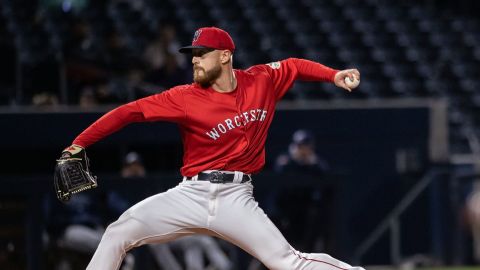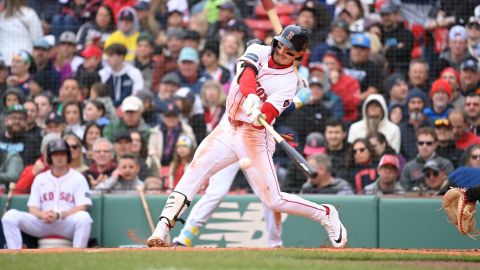 Remember the second-to-last scene of the film version of Moneyball?
Remember the second-to-last scene of the film version of Moneyball?
If you don't, it features an actor portraying Boston Red Sox owner John Henry courting Brad Pitt — excuse me, courting Billy Beane (really now, who doesn't want to court Brad Pitt?), and specifically telling the general manager that any teams that aren't using his methods of player evaluation are "dinosaurs." Where the movie stretches is in its epilogue, where it claims the Red Sox won the World Series two years later by incorporating Beane's theories.
This is wrong for two reasons. One is that the Red Sox had plenty of high-priced talent on their 2004 squad, and it takes much longer than two years to make the totality of changes necessary to run a baseball club perscribed in Michael Lewis' book, upon which the film was based. The other falsehood is that Beane had much to do with the origin of Moneyball-type analysis.
Nonetheless, what is accurate about that scene is that many teams — while incorporating evaluation through mathematical analysis — hadn't fully jumped on board yet with the new way of doing things. By 2012, however, Major League Baseball, unlike the dinosaurs, has taken the next evolutionary step.
Nowadays, players are evaluated by certain principles that are no longer undervalued like they were in 2002. The most obvious of these — and the example that we'll come back to — is that a stat like batting average is now less important than on-base percentage. Players like Adam Dunn and Nick Swisher may have been overlooked in 2002, but now they're (rightly) considered among baseball's most valuable hitters.
But here's the thing: Moneyball is specifically a term that refers to getting bargains for finding undervalued players and giving appropriate importance to marginalized metrics of evaluation. For a team like the Oakland A's, for instance, that meant finding bargains by investing in players whose on-base skills were undervalued.
But what happens when the old market inefficiencies aren't inefficient anymore? What happens when all the other teams in baseball are looking for the same previously undervalued skills your team is?
That's the challenge the Oakland A's faced coming into the 2011-2012 offseason, and it's the challenge the Red Sox will face in putting a competitive roster together in 2013 and beyond. And, as the Red Sox visit Oakland this weekend, they ought to be looking toward Oakland's offices beyond right field for an example to emulate in running a baseball club under the principles of the "new Moneyball."
In short, the moral is this: The Oakland Athletics have never been a team concerned with specific sexy stats. They are not hung up on OPB, WAR, OPS+, BABIP or any of the newfangled acronyms that dominate what's really going on behind the scenes in baseball. The A's will take value any way they can get it.
Of course, for a team like Oakland, which has extremely limited financial resources, the importance of finding undervalued players is that much greater. The Red Sox have the ability to take on much more payroll and can go out and get high profile players when they think it's appropriate.
However, when general manager Ben Cherington gave his post-mega-trade press conference a week ago Saturday, he repeatedly used the word "discipline" to describe how the Red Sox would operate going forward. What everyone presumes Cherington meant was that the team would be much more hesitant to go after player who they'd have to get into a bidding war to acquire.
While the Red Sox will of course still continue employ high-priced talent, there's clearly going to be a much greatet emphasis on player value in the future.
That means the Red Sox' old ways of evaluating players will have to change and evolve to stay out ahead of the rest of MLB. If they're looking for value, that means players like J.D. Drew and Kevin Youkilis — high-OBP guys who signed team-friendly contracts — aren't really in the equation anymore, as such players just aren't undervalued for the skills they bring to the diamond the same way.
So, what are the principles of "Moneyball 2.0"? Well, for one, the A's have put a ton of money into the international market, most notably with the signing of outfielder Yoenis Cespedes this offseason. Oakland clearly took a gamble, but they identified the Cuban as someone whose production would be greater than the value of his contract — and they turned out to be exactly right.
Another surprising turnaround for the A's is their aggressiveness on the basepaths, ranking eighth in MLB with 102 steals. One of the clear tenents of the old Moneyball was to not give a team extra outs — to just stick to station-to-station baserunning. Well, apparently Oakland has identified that speed is an undervalued asset and has been willing to adjust its gameplan as such.
Likewise, it should be noted that the A's rank 23rd in MLB with just 26 sacrifice bunts, so some aspects of their philosophy haven't changed. In fact, the core of Moneyball continues to remain consistent — the ability to develop players within the minor league system remains integral.
It's still the case that no one can build a competitive team from scratch, and while it's a huge advantage to be able to go out and get expensive, talented pieces, a winning team needs to be highly complemented by young players under team control. And give credit to the Red Sox, as they've been able to add a couple high-ceiling prospects from the Dodgers in Rubby De La Rosa and Allen Webster, who will help their organizational depth. The development of players like Xander Bogaerts and Jackie Bradley, Jr., though, will still do a lot to determine Boston's future.
To sum it all up, the Red Sox are going to have to get highly creative and look for brand-new market inefficiencies to be able to compete in 2013 and beyond. We're not even sure what that might mean, but Cherington and his team are almost certainly working on determining where value can be found as we speak.
And, like the Athletics, Boston is certainly going to have to take a gamble or two to find that value.



